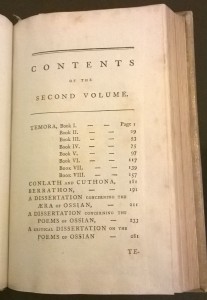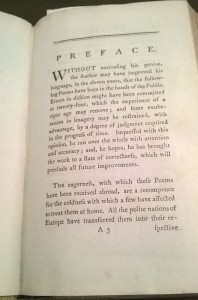The Poems of Ossian, By James MacPherson (1785)
How you market a book has a great influence on how well or poorly it comes across to the public. A book that is advertised as funny that ends up being serious may not sell as well or be reviewed as well as it would be if the advertising was accurate. People do not like to be misled, especially when advertising is involved. A man who learned this lesson was James MacPherson.
 Title Page of the second edition of The Poems of Ossian
Title Page of the second edition of The Poems of Ossian
MacPherson was a Scottish Highlander and native speaker of Scots Gaelic. When he met dramatist John Home in 1759, he was renowned as being a great scholar. Over the course of the evening, the topic of Gaelic poetry came up, which Home was very interested in. Eventually, Home convinced MacPherson to translate Gaelic poetry and publish a book of these poems, which was printed in 1760. The poems were epics that told the tale of Ossian. Home and Hugh Blair—a professor at the University of Edinburgh—were fascinated by Ossian’s story and encouraged MacPherson to translate more of his story. However, they were unaware of the fact that MacPherson had reached the end of the known Gaelic lore of the Scottish Highland.
Contents page for the first volume of The Poems of Ossian
In spite of this, MacPherson published more books, including The Poems of Ossian. A second edition was published of The Poems of Ossian and by that time he had reached considerable fame in London. With more popularity and people reading his work, more people became more critical his work. People began to question the authenticity of the translation and said that his work was being influenced by Irish lore. His books soon became a fight over which country owned these stories and whether or not they were really translations of Scottish poems.
Contents Pages of the second volume of The Poems of Ossian
Despite the widespread controversy over his work, the academic integrity of the work was not investigated until after MacPherson’s death in 1796. The Highland Society of Scotland examined the issue and published inconclusive findings in 1805. The society found that MacPherson’s book was not a translation but a collection of Highland stories, which was how MacPherson sometimes advertised his stories. The question of the authenticity of his translation was revived in the late 19th century. It has since been confirmed that The Poems of Ossian is just a retelling and reworking of traditional stories. MacPherson tried to create a history and a story around these poems so they would be saved; he just did it unscientifically. One good thing did come out of the scandal though. Preservation of Gaelic manuscripts was encouraged, and the scandal initiated the growth and protection of Gaelic literature.
First page of the preface to the second edition of The Poems of Ossian
In a different time, MacPherson’s Ossian may not have caused a scandal. In the late nineteenth century, the historic novel was all the rage. Had he been born then and advertised his work as a historic novel, his legacy would not be tied with a great forgery but a great novel. His book was amazing, but because he sold it as a translation, it is notorious instead of famous. Through MacPherson’s story, we can see the effect that advertising can have on the legacy of a book. The simple reworking of how the book was presented to people would have changed its place in history.
—
Works Consulted
Dowe, William. “MacPherson’s Ossian.” Appletons’ journal: a magazine of general literature 8.176. University of Michigan: Humanities Text Initiative. Web.
Mauder, Andrew. “Works of Ossian, The James Macpherson (1765).” Encyclopedia of Literary Romanticism. New York: Facts on File, 2010. Web.
McCraith, Michael. “The Saga of James MacPherson’s ‘Ossian.'” The Linen Hall Review 8.2/3 (1991): 5-9. Web.



